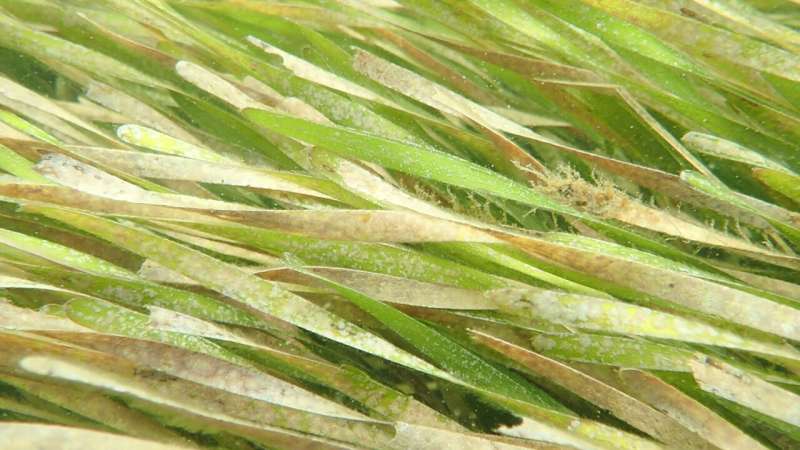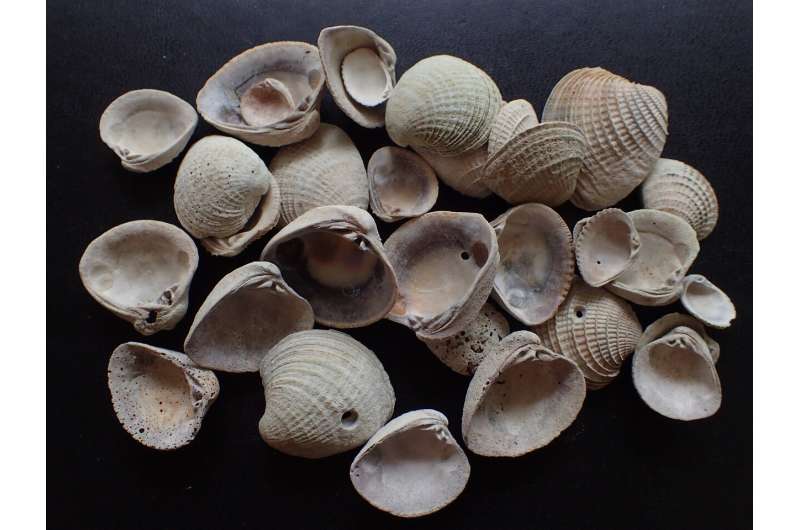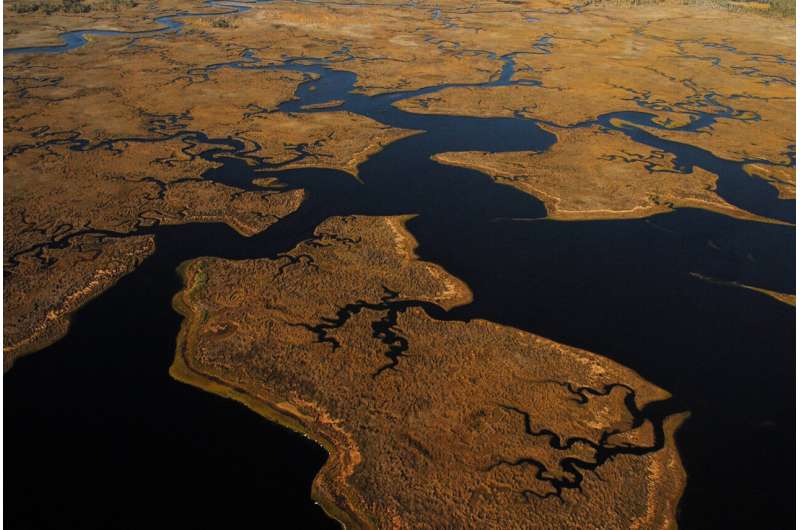Seagrass meadows harbor wildlife for centuries, highlighting need for conservation

Seagrass meadows put down deep roots, persisting in the same spot for hundreds and possibly thousands of years, a new study shows.
Seagrasses, crucial sources of shelter and food for thousands of species, are threatened globally by coastal development, pollution and climate change. While scientists have documented the health of seagrass meadows over several years or decades, assessing these habitats at the scale of centuries or millennia has been a much greater challenge.
University of Florida researchers used modern and fossil shells from seagrass-dwelling animals to estimate the age of these meadows, showing that, far from being transient patches of underwater weeds, they are remarkably stable over time.
They also found that seagrass meadows were home to a much richer variety of animals than bare sandy seafloor, highlighting the importance of seagrasses as critical long-term reservoirs of biodiversity in coastal ecosystems.
"This is one more reason to advocate for seagrass conservation and preservation," said the study's lead author Alexander Challen Hyman, who conducted the research as a master's student in UF's School of Natural Resources and Environment. "This study highlights how vital seagrasses are as habitats. Not only are they hotspots of biodiversity, but they're enduring and stable hotspots over time."
Seagrass meadows transform their surroundings by slowing wave energy, improving water quality and clarity, storing carbon and stabilizing the seafloor. By tempering outside forces, the meadows attract a variety of fish, birds, marine mammals, invertebrates and algae. In Florida, they provide nursery habitats for an estimated 70% of the fish that Floridians catch and eat and are also the dietary staple of manatees and green sea turtles.
But seagrasses are some of the planet's most threatened ecosystems. A 2009 study revealed that mapped seagrass meadows have decreased globally by an estimated 29% since records began in 1879, and the rate of loss is accelerating.

To understand how meadows have changed over time, scientists turned to the emerging field of conservation paleobiology, which adds the fossil record to research of modern ecosystems.
"We don't have a time machine to visit coastal regions of the past and verify that seagrass was there," said Michal Kowalewski, Thompson Chair of Invertebrate Paleontology at the Florida Museum of Natural History and the study's principal investigator. "But we can use shells as a way of glimpsing how these habitats functioned before the Industrial Revolution and whether they persist over time or pop up and then vanish."
Ecologists can often assess the health and biodiversity of today's marine ecosystems simply by studying the local mollusk community—animals such as snails, slugs, oysters and mussels. For paleontologists such as Kowalewski, however, the fossil shells of mollusks can also be a portal deep into an ecosystem's past.
"Mollusks are abundant, diverse, ecologically important and very well represented in the fossil record," he said. "They can often be identified to species just from their shells. The dead are powerful storytellers about what previously lived in an ecosystem."
The team collected and identified more than 50,000 shells from seagrass meadows and open sandy areas in Florida's Big Bend region on the Gulf Coast, one of the most pristine coastal ecosystems in the U.S. The shells represented both living and dead mollusk communities. Radiocarbon dating showed that 40% of the shells were more than 500 years old, with the oldest shell being nearly 2,000 years old.
By comparing the abundance and type of old shells with living species, the team could get a sense of whether a particular habitat had changed. If the two communities mirrored one another, the modern and ancient habitat likely did as well. But if researchers saw a mismatch, they would know the habitat had shifted over time.
"If you're in a desert, surrounded by snakes, cacti and coyotes, but you dig down and find whale bones, you would assume there had been a large change in habitat," said Hyman, now a doctoral student at the Virginia Institute of Marine Sciences. "This works on the same principle."

The researchers found that living and dead mollusk communities in seagrass meadows matched one another, suggesting that the seagrasses they sampled have grown in the same location for centuries or longer, Kowalewski said.
"The patchwork of open sandy bottoms and seagrass meadows that we see today is not a transient, ever-shifting mosaic," he said. "Our data suggest that seagrasses are not dramatically shifting around and changing location."
Mollusk communities were also much more consistent from meadow to meadow compared with communities in open sandy areas, which differed widely according to place and time. Hyman said that while seagrasses provide structural stability, sandy areas are far more vulnerable to storms or unusual shifts in local conditions, making their communities more variable.
"Sand cannot buffer physical extremes the way that seagrasses can," he said. "The stability of seagrass meadows likely contributes to their biodiversity and productivity."
The study's findings have profound conservation and management implications, said Florida's Chief Science Officer Tom Frazer, who co-authored the paper.
"If we are unable to prevent seagrass loss in a particular area, we may not be able to make up for that loss by trying to establish a new meadow elsewhere," he said. "This realization only heightens the need for immediate action aimed at improving water quality in estuaries and coastal waters around the state."
"Meadows have deep historical roots," Kowalewski added. "If that's the case, there's something priceless about the location, not just about the seagrass itself."
More information: A. Challen Hyman et al, Long-term persistence of structured habitats: seagrass meadows as enduring hotspots of biodiversity and faunal stability, Proceedings of the Royal Society B: Biological Sciences (2019). DOI: 10.1098/rspb.2019.1861
Journal information: Proceedings of the Royal Society B
Provided by Florida Museum of Natural History
















